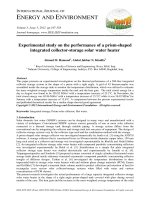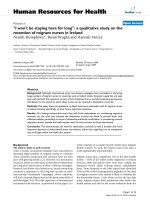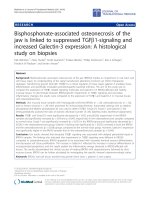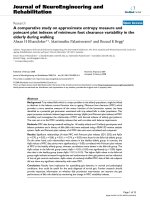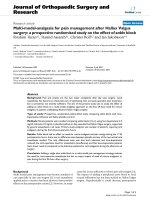A preliminary study on the current situation of the green areas and water bodies in the inner city of Hanoi
Bạn đang xem bản rút gọn của tài liệu. Xem và tải ngay bản đầy đủ của tài liệu tại đây (3.41 MB, 8 trang )
RESEARCH RESULTS AND APPLICATIONS
A PRELIMINARY STUDY ON THE CURRENT SITUATION
OF THE GREEN AREAS AND WATER BODIES IN THE INNER
CITY OF HANOI
Nguyen Quang Minh1*, Ta Quynh Hoa2, Phung Thi My Hanh3
Abstract: In Hanoi, the capital city of Vietnam, the awareness of the roles and benefits of greening in both
previously and recently urbanised areas has been growing over the years. Green areas and water bodies
play a vital role in maintaining the city as a comfortable living environment for residents and making it also a
bio-sphere for numerous species as far as bio-diversity is concerned. In modern urban planning theory, the
importance of landscape and ecology has been emphasised, with regard to the past as Hanoi was identified
for street tree planting and known as a water-based city. As a result, planners and decision-makers propose
a combination of water bodies and green areas, using cultural as well as historical values as an argument to
support the re-greening programme in a strategic development concept for the city planning in Hanoi. This
study focuses on the inner city first where a citywide network of water surface and city parks has already
existed yet continues to decrease in both quantity and quality under the huge impact of today’s rapid urbanisation in the vigorous development of the market economy. Improving the cityscape and making the city a
livable place for residents will not go without understanding well the current situation or taking an in-depth
view of what the city still lacks and thus really needs in its infrastructure systems.
Keywords: Green areas, water bodies, city landscape, sustainability.
Received: September 15th, 2017; revised: October 10th, 2017; accepted: November 2nd, 2017
1. Introduction of the current situation of landscape in Hanoi - green areas and water bodies
According to the City Development Master Plan towards 2030 with visions until 2050, Hanoi is supposed to be a politico-administrative centre of a one-hundred-million-inhabitant country as well as a major
powerhouse for culture, science and technology, education and training, economy, tourism and trading in
the Asia-Pacific region.
In the future, Hanoi will be going ahead and becoming a “City of Green-Culture-Civilisation-Modernity”. The capital city is developing on the basis of the values conserved with natural landscape, such as
mountains in Ba Vi, Tam Dao and Huong Son, abundant green spaces on account of fertile agricultural
land and also rich in terms of culture on the basis of traditional villages and a system of historical monuments, for example Temple of Literature and thousands of other heritage buildings. The long history
spanning over 1,000 years of Hanoi has shaped such a distinctive feature that may not be found anywhere
else in the country. Hanoi is also striving for a stronger and more dynamic economy with a modern and
complete urban infrastructure. However, the heritage assets, both tangible and intangible ones, should
be kept by all means, because they stand for a well-established culture in one of the country’s earliest
cradles of civilisation.
Multi-central city is considered an appropriate concept for the future development of Hanoi, as shown
in Fig. 1. The districts in the centre and the satellite towns in the periphery will be interconnected and together they form a complete road network with an effective transit transport system. This is proved to be a
suitable model for many mega-cities in developing countries and for Hanoi as well. It is reported that in 2020
- 2030 the urban population in Hanoi will amount to 6.2 million people, of which approximately 2.9 million
Dr, Faculty of Architecture and Planning, National University of Civil Engineering.
Dr, Faculty of Architecture and Planning, National University of Civil Engineering.
3
MSc, Faculty of Architecture and Planning, National University of Civil Engineering.
* Corresponding author. E-mail:
1
2
JOURNAL OF SCIENCE AND TECHNOLOGY IN CIVIL ENGINEERING
Vol. 11 No. 6
11 - 2017
133
RESEARCH RESULTS AND APPLICATIONS
will be living in rural areas of the metropolitan territory and the urbanisation rate will reach 65 to 68%. The
population density in nine districts of the inner city (except Long Bien district) is estimated at almost 14,000
inhabitants/km2, and this will reduce gradually to 11,000 inhabitants/km2 in 2050. The other districts will have
a demographic density of less than 10,000 inhabitants/km2 [1].
Figure 1. The Master plan of Hanoi Capital untill 2030 and visions to 2050 [1]
The spatial planning is largely based on the connection between natural factors and cultural assets
(river and lake system, bio-diversity, existing old street quarter and traditional villages, cultural characteristics
and the soul of handicraft, etc.). “Green corridor” and “green belt” as two concepts applicable to Hanoi Region
could be further developed. In the future city development structure, the green corridors account for about
70% of the natural land area, including the whole rural area of Hanoi [1]. The green corridors spread along the
Day River, the Tich River, the Nhue river, Ba Vi mountain and Huong Tich site, along the city ring road no. 4,
crossing the Red River, connected to the area around Soc Temple. The green corridors help separate urban
areas and restrict the spontaneous urbanisation. The green corridors consist of several components, such as
natural conservation areas, agricultural development areas, villages and cultural heritage sites.
The most important visions and strategies taken
from the Ministry of Construction’s Master Plan approved by
the Prime Minister in 2011 with regard to green areas and
water bodies are noted and summarised as follows:
- To develope and conserve rural areas and natural
forests.
-To manage green belts and green buffer zones,
to prevent the expansion from the inner city, especially between ring road no. 3 and ring road no. 4.
- To optimise the nature resources of parkland and
water surface.
- To integrate landscape design into environmental
solutions in order to create more links among existing parks
and lakes [1].
In general, Hanoi consists of various features of charming landscape typologies with different hydro-geological conditions and fertile soil of a delta region, which are very favourable
for the development of flora and fauna. They also offer a wide
range of rain forest eco-systems, agricultural productions, rivers, lakes, ponds and canals. This is an important prerequisite
for creating a truly green city and ecological landscape with so
many greenery and water attractions (Figs. 2, 3 and 4).
134
Vol. 11 No. 6
11 - 2017
Figure 2. The current status of landscape
in Hanoi Capital [2]
JOURNAL OF SCIENCE AND TECHNOLOGY IN CIVIL ENGINEERING
RESEARCH RESULTS AND APPLICATIONS
Figure 3. Aerial view of Hoan Kiem lake [3]
Figure 4. Lotus pond in West Lake [4]
In fact, Hanoi is a mega-city with typically high tropical climate, hot and humid in summer months
(May to August) which may bring unpleasant feelings. Thus, large tree shadows and water surfaces are
so much needed to cool down the atmosphere. They will help improve the living environment for millions
of people.
Moreover, in recent years, there have been potential risks such as flooding, lower groundwater level,
ground subsidence, air and water pollution, urban heat island effect, etc. which directly come from the diminution of green areas and water bodies (hereafter indicated as green-and-blue network). These risks have
left negative impacts on buildings, infrastructure and living environment across the city. Therefore, in consideration of a long-term vision, Hanoi must pay more attention to these problems, including those related to
water. While the current problems have not yet been solved, the capital city authority and community must
face and deal with new challenges as a consequence of uncontrollable urbanisation, as clearly reflected in
two record summer heat waves hitting the city in 2016 and 2017 with mid-day air temperature level measured at 42.5oC. The on-going climate change has made the situation even worse.
With these in mind, the article aims to evaluate the current situation of the green-and-blue network
in Hanoi and point out some initial findings that may pave the way for the authors’ investigation into the city
greening in the future and help enhance both the cityscape and the living quality for the city residents. A
number of research methods have been used for this purpose, namely data collection, evaluation and analysis and site survey.
2. Overview of the development process
Urban trees, parks, mini-parks and
flower gardens in Hanoi were systematically
planned and developed by the French from
the colonial time, mainly in the districts of
Hoan Kiem and Ba Dinh. The Botanical Garden formed a large part of it. The French
knew how to make full use of the transitional
spaces between the old and new quarters
Figure 5. Chronological increase in the number of urban
and turn them into green buffer zones. In
parks and mini parks in Hanoi [5]
some parts of the French quarter, such a
green network has still been well kept, such as in Phan Dinh Phung street (Ba Dinh district), Tran Hung Dao
street (Hoan Kiem district) and Lo Duc street (Hai Ba Trung district).
In the 1960s of the 20th century, the first two public parks (Thong Nhat and Thu Le) were built from
old landfills by the city residents, particularly by the youth undertaking volunteer work. These projects helped
to enlarge green spaces for recreation purpose in that period (Figs. 5 and 6).
The subsequent period - from the early 1960s until 1986 - there were many socialist neighbourhoods
in the city constructed and green issues were properly considered in terms of planning standards. The distance between the apartment blocks were reserved for green areas with different types of plants such as
JOURNAL OF SCIENCE AND TECHNOLOGY IN CIVIL ENGINEERING
Vol. 11 No. 6
11 - 2017
135
RESEARCH RESULTS AND APPLICATIONS
willow trees, tropical almond trees, lagerstroemia trees, eucalyptus trees, etc. which had a significant effect
in regulating the local climate, as seen in typical settlements of Kim Lien, Trung Tu, Thanh Cong, Giang Vo
and Khuong Thuong (Figs. 5 and 7).
In the late 20th century, the economic boom, the lack of control policies and especially the fast population growth rate have together put a heavy pressure on the urban development, leading to the large-scale
occupation of, public places and open spaces and making the green-and-blue network disappear quickly in
terms of quantity. Nevertheless, the total area of park kept on rising, as shown in Fig. 5.
Lately, there has been a major change in the public awareness, as well as in the attitude of the authorities towards the importance of green issues to the urban development. How to increase the green areas
in the city has become a topical question. The efforts can be seen through a number of new parks and gardens planned after the year 2000: Hoa Binh park, 01-06 flower garden, mini parks and walk ways in urban
areas in the periphery, for instance My Dinh 1, My Dinh 2, Van Quan town, etc.
Figure 6. Non-profit labour for the first public park in the early socialist years in Hanoi [6]
Figure 7. Green spaces between apartment blocks have been diminished in Trung Tu ward (left)
and Kim Lien (right) [7]
3. The current state of parks, mini-parks and flower gardens in the inner city
At present, in central districts like Hoan Kiem and Ba Dinh, the system of parks and flower gardens
failed to meet the needs of the local people, due to the limited area and the high population density. Hoan
Kiem Lake together with the surrounding green areas still remains as one of the most outstanding landscape
features and tourist attractions in the centre of Hanoi.
The other existing large parks such as Thu Le park and Botanical park (Ba Dinh district), Thong Nhat
park (Hai Ba Trung district) vary from 10 to 50 ha in area. In addition, these green areas are often connected
with relatively large water bodies, such as West lake, Truc Bach lake, Giang Vo lake, Ngoc Khanh lake, etc.
They have contributed to the urban landscape and considerably improved the local micro-climate conditions.
Among them, Thu Le park, Thong Nhat park and Tuoi Tre park have been upgraded to become more modern
and attractive, hereby meeting the higher recreation and relaxation demand of the inhabitants (Figs. 8 and 9).
However, in central districts, there are almost no more open areas for greening the city. In new urban
development projects, most of the green areas are small in size and scattered in distribution, therefore unable to form an efficient network. Moreover, the types of trees have not yet been well selected. Meanwhile,
the number of old tall trees with thick foliage and large shading areas keeps on decreasing, because of trop-
136
Vol. 11 No. 6
11 - 2017
JOURNAL OF SCIENCE AND TECHNOLOGY IN CIVIL ENGINEERING
RESEARCH RESULTS AND APPLICATIONS
ical storms hitting the city several times a year and even as a result of the controversial plan of cutting down
6,700 trees for the construction of new tramlines in autumn 2015 and most recently an additional amount of
1,300 tall trees along Pham Van Dong road for the same purpose.
Figure 8. Tall trees in Hoang Dieu road [4]
Figure 9. Walk way in Thong Nhat park [4]
The quantity and size of urban parks, flower
gardens and walkways are obviously insufficient in
comparison to a fast growing rate of urban population.
Some places are even illegally occupied and misused
while theme parks for people to relax and natural
parks for scientists to conduct research continue to be
endangered by urban land fever and new real estate
projects. In highly urbanised districts like Dong Da and
Thanh Xuan, the greenery rate is rather low, just under
0.5m2/person [5]. Yen So park, Hoa Binh Park, Linh
Dam park and lake, Nhan Chinh park and lake are
some examples of new green and/or green-and-blue
network planning schemes over the past few years.
There are four theme parks: Botanical parks, Hanoi
zoo, West lake Water park and Bao Son Paradise
park. The latter is not situated in the inner city.
Figure 10. Distribution of parks in Hanoi by
administrative division [2]
According to the statistics provided by the City Park Management Unit, Hanoi has now 66 parks and
flower gardens, covering a total area of 334 ha. They vary in size, mostly between 10 and 15 ha. The largest
one is Yen So park - 67 ha (Fig. 10). In the city centre, there are eight medium-size parks [5]. They all need
to be expanded, upgraded or modernised to become standard parks.
4. The current state of inner-city green-and-blue network
The green area per capita is relatively low, at 5m2/
person in the whole city while in the central district, this index
is just estimated at about 2 to 3m2/person [5]. In the City Development Master Plan for Hanoi issued in 1998 by the Ministry of Construction, the green area per capita is expected
to reach 15m2/person by the year 2020. The total green area
and the greening indicator are given in Figs. 11 and 12 below.
As part of greenery, trees rows along the street have
always been closely connected with the cityscape of Hanoi.
In the French quarter, street trees were very carefully selectFigure 11. Area of the parks and gardens by ten
ed and usually well planted. In some main streets, the trees
inner city administrative division [5] As Nhan
were homogeneous and have therefore created the identity
Chinh park-and-lake project has not yet been
of each street, such as the Dracontomelon duperreanum in finished, the extremely low green-area-per-capita
Phan Dinh Phung street, the Hopea odorata in Lo Duc street, indicator of Thanh Xuan district remains at almost
0 m2/person as of summer 2017
the Alstonia scholaris in Nguyen Du street and Quang Trung
JOURNAL OF SCIENCE AND TECHNOLOGY IN CIVIL ENGINEERING
Vol. 11 No. 6
11 - 2017
137
RESEARCH RESULTS AND APPLICATIONS
Figure 12. Statistics of street tree area per capita in the inner city [5]
street, the Delonix regia in Ly Thuong Kiet street, the
Khaya senegalensis in Hoang Dieu street, etc. In the Old
quarter, because of the narrow streets, alleys and sidewalks, only small trees were chosen (Fig.13).
With approximately 45,000 trees in nearly 500
streets surveyed recently across the core city [5], the
street greenery in Hanoi is more abundant and characteristic than in many other cities of the country. There
are many roads with boulevard-style median strips such
as Nguyen Chi Thanh boulevard, Thang Long avenue,
Lac Long Quan road that have also contributed to the
green lines connecting different urban functional areas
in the city.
Apart from the network of rivers like the Red river,
the Duong river, the Nhue river, the To Lich river, the Lu
river, the Set river, etc., Hanoi is a city with so many lakes
and ponds (Fig.14). Currently, there are 111 lakes and
ponds with a total area of about 1,146 ha throughout 10
urban districts: 46 lakes have been renovated (15 completely renovated) and the remaining (65 lakes) should
be dredged as soon as possible, in order to regulate the
abundant amount of rainwater in the rainy season and
store water in the dry season [8].
Most of the lakes are contaminated by waste water
from local households. The majority of them (except West
lake) is not capable of self-cleaning. In order to deal with
the water pollution, biological treatment has been applied.
The lakeside roads are often not well managed, thus it is
difficult to control the encroachment of lakes and the disposal of solid/liquid waste into the water (Figs.15 and 16).
The river network in the inner city includes the
Red river and four drainage rivers. Most of the rivers flow
through the inner city. Waste water from households and
industrial zones/factories is discharged into these four
drainage rivers. The Kim Nguu river alone takes up a
huge amount of untreated waste water estimated at about
120,000m3 per day [9]. The air, the underground water
and the soil are contaminated with stench, heavy metals
and organic substances. These factors have a long-term
negative influence on the public heath.
138
Vol. 11 No. 6
11 - 2017
Figure 13. Distribution of street trees
in Hanoi [2]
Figure 14. Lakes and rivers in
Hanoi inner city [2]
JOURNAL OF SCIENCE AND TECHNOLOGY IN CIVIL ENGINEERING
RESEARCH RESULTS AND APPLICATIONS
Figure 15. Kim Lien lake after renovation [4]
Figure 16. To Lich river is highly polluted [4]
At present, some of the lakes and rivers have been renovated to maximise the rain water storage
capacity and flow speed. Thereby it is possible to reduce the potential threat of flooding each time when it
rains heavily and at the same time to improve the landscape as well as to bring back the past memory as a
romantic water-based city to the city dwellers.
5. Highlight of key findings and suggestions for solutions
The inner city of Hanoi should take the advantage of the current green-and-blue network which has
been partially diminished in recent years due to the rapid urbanisation, either accidentally or intentionally, for
a good cause or not. Many of the special features are, nevertheless, still there which require prompt action
programmes in order to maintain the identity and restore the beauty of the capital city.
Except some particular cases, the quality of the current green-and-blue network in Hanoi, especially
in the inner city, is inadequate. The term quality here does not only deal with trees or plants, but also urban
facilities, such as lighting systems, waste collection and utilities for public use. Such facilities and utilities are
rather poor because they are not properly taken into account. As a consequent, the parks do not attract as
many people as expected. Some of the green areas even have become nests for social evils. A few parks
are, on the contrary, always overcrowded.
The inner city park system exists primarily in small size and their distribution is scattered. As an
integral part of the urban eco-system, street trees should however not be counted in the green area per
capita indicator. The lake-and-river cleaning programme is actually not so successful, because of the huge
amount of waste water directly discharged into the open canals and rivers. Waste water, particularly black
water, must be technically well treated on-site and this requires a comprehensive and intensive investment.
Technology transfer and financial aid from various NGO’s are available.
The City Development Masterplan for Hanoi until 2030 with vision to 2050 can be regarded and used
as a powerful legal instrument for the protection, optimisation and expansion of the green-and-blue network
towards the ultimate goal of becoming a “real green city” with green belts, green corridors, satellite towns
and eco-cities. According to this ambitious plan, the greening rate will be expected as high as 70% of the
total city area [1].
Green factors (city parks, district parks, neighbourhood flower gardens, street plants, etc.) and blue
factors (rivers, canals, lakes and ponds) should be much better connected together and open to people of all
ages. A concept of social communication should be incorporated in the greening programmes. In the inner
city, where building density is extremely high, the existing greenery and water system must be protected
by all means. The first bold step to be taken should be the confiscation of all green areas and water bodies
illegally occupied. Then, the restored network will need to be enlarged and developed into a citywide system
in line with the depopulation schemes aimed at central districts. Another possibility to be considered would
be the revitalisation of several old industrial sites and factories/workshops from the 1960s, 1970s and 1980s
(commonly known as brownfield zones) in the inner city and the transformation of these sites into park-andlake areas, instead of developing new real estate or commercial building projects.
JOURNAL OF SCIENCE AND TECHNOLOGY IN CIVIL ENGINEERING
Vol. 11 No. 6
11 - 2017
139
RESEARCH RESULTS AND APPLICATIONS
Conclusion
There is deep concern that the more Hanoi develops, the less green and blue area it will have. Green
and blue components have been and continue to be vital to the development of the city throughout its history. The enlargement and improvement of both parks and lakes should be regarded as one of the long-term
development strategies and the ultimate aims for the city council and people to achieve step by step. The
crucial point is a rather social than technical issue, as it has so much to do with the management capabilities
of the authorities and the active participation of the public./.
References
1. Ministry of Construction and National Institute of Urban and Rural Planning (2011), Report of City Development Master plan of Hanoi to 2030 with vision to 2050.
2. Hanoi Urban Planning Institute (2013), Planning the green system of parks and water surface in Hanoi
according to the year 2030 and vision to the year 2050.
3. Waibel M. (2015), Hanoi Capital City, Universität Hamburg und Goethe Institut, cover page picture.
4. Minh N.Q. (2014, 2016, 2017), City surveys.
5. Hanoi Single Member Co. Ltd of Parks and Trees (2014), Greenery development strategy for Hanoi
until 2020.
6. www.baotintuc.vn.
7. www.kinhtedothi.vn.
8. Hoa T. Q. (2011), Urban water management in Hanoi city - Prospect and challenges, Southeast Asian-German Expert Seminar on Urban Regional Network of Urban Environmental and Risk Management in Southeast Asia, International Conference, Philippines.
9. World Bank (2015), Assessment of urban waste water treatment in Vietnam, ldbank.
org/curated/en/946371468245428281/pdf/ACS77120v20 VIE0ort0Vietnamese0final.pdf.
140
Vol. 11 No. 6
11 - 2017
JOURNAL OF SCIENCE AND TECHNOLOGY IN CIVIL ENGINEERING
